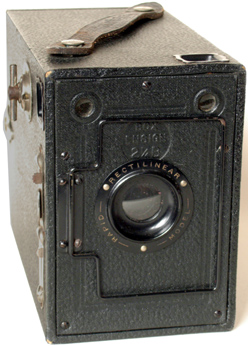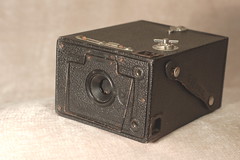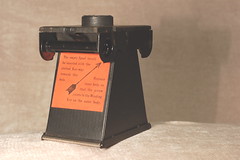Difference between revisions of "Box Ensign 2¼ B"
(date correction, lens cap, image size) |
m (image update) |
||
| Line 1: | Line 1: | ||
{{stub}} | {{stub}} | ||
{{Flickr_image | {{Flickr_image | ||
| − | |image_source= http://www.flickr.com/photos/awcam/2466950355/in/pool- | + | |image_source= http://www.flickr.com/photos/awcam/2466950355/in/pool-camerawiki |
|image= http://farm3.static.flickr.com/2390/2466950355_aee6ed13d3_o.jpg | |image= http://farm3.static.flickr.com/2390/2466950355_aee6ed13d3_o.jpg | ||
|image_align= left | |image_align= left | ||
| − | |image_text= Black, [[Rapid Rectilinear]] (RR) model | + | |image_text= Black, [[Rapid Rectilinear]] (RR) model |
| + | |image_by= AWCam | ||
| + | |image_rights= With permission | ||
}} | }} | ||
The '''Box Ensign 2¼B''' was made by [[Houghton and Ensign|Houghton-Butcher]] in the UK around 1923<ref>{{McKeown}}, p.394</ref>. It took 2¼×3¼ (6×9cm) negatives on [[120 film]] (Ensign 2¼B film). It has a simple rotary I/T shutter. There was also a 2¼A model, for 2¼ square images. | The '''Box Ensign 2¼B''' was made by [[Houghton and Ensign|Houghton-Butcher]] in the UK around 1923<ref>{{McKeown}}, p.394</ref>. It took 2¼×3¼ (6×9cm) negatives on [[120 film]] (Ensign 2¼B film). It has a simple rotary I/T shutter. There was also a 2¼A model, for 2¼ square images. | ||
| Line 17: | Line 19: | ||
|image= http://farm4.static.flickr.com/3399/3306860933_f18524edfc_m.jpg | |image= http://farm4.static.flickr.com/3399/3306860933_f18524edfc_m.jpg | ||
|image_align= right | |image_align= right | ||
| − | |image_text= Meniscus model | + | |image_text= Meniscus model |
| + | |image_by= Scribex | ||
| + | |image_rights= Creative commons | ||
}}{{Flickr_image | }}{{Flickr_image | ||
| − | |image_source= http://www.flickr.com/photos/ | + | |image_source= http://www.flickr.com/photos/10456228@N00/5456129150/in/pool-camerawiki |
| − | |image= http:// | + | |image= http://farm6.static.flickr.com/5300/5456129150_776447b578_m.jpg |
|image_align= left | |image_align= left | ||
| − | |image_text= Leather-grain finish | + | |image_text= Leather-grain finish, with lens cap |
| + | |image_by= Morinaka_2010 | ||
| + | |image_rights= With permission | ||
}} | }} | ||
{{Flickr_image | {{Flickr_image | ||
| Line 28: | Line 34: | ||
|image= http://farm4.static.flickr.com/3618/3307692580_918e97508d_m.jpg | |image= http://farm4.static.flickr.com/3618/3307692580_918e97508d_m.jpg | ||
|image_align= right | |image_align= right | ||
| − | |image_text= film carrier | + | |image_text= film carrier |
| + | |image_by= Scribex | ||
| + | |image_rights= Creative commons | ||
}} | }} | ||
Revision as of 03:05, 19 February 2011
This article is a stub. You can help Camera-wiki.org by expanding it.

|
| Black, Rapid Rectilinear (RR) model image by AWCam (Image rights) |
The Box Ensign 2¼B was made by Houghton-Butcher in the UK around 1923[1]. It took 2¼×3¼ (6×9cm) negatives on 120 film (Ensign 2¼B film). It has a simple rotary I/T shutter. There was also a 2¼A model, for 2¼ square images.
There seem to have been at least two models, one with a meniscus lens, another with a Rapid Rectilinear (RR) lens, with a choice of three (unlabelled) apertures selected by a slider above the shutter release. Some versions have a plug-type lens cap, made of leatherette-covered card, attached by a string to the lens surround.
There are two Watson-type finders and a wire frame finder which folds down over the front.
It was available in black, or a leather-grain effect brown.

|
| Meniscus model image by Scribex (Image rights) |

|
| Leather-grain finish, with lens cap image by Morinaka_2010 (Image rights) |

|
| film carrier image by Scribex (Image rights) |